HI5017: Managerial Accounting - Budgeting Research Studies Report
VerifiedAdded on 2023/06/07
|15
|4537
|165
Report
AI Summary
This report examines the significance of budgeting for business organizations, irrespective of their nature. It analyzes budgeting concepts through research articles from a profit-gaining and a non-profit organization. The evaluation emphasizes the importance of budgeting before commencing business projects, aiding in decision-making by gathering necessary information. The report details the budgeting process, including planning, evaluation, selection, implementation, control, and review. It also discusses the purpose of budgeting, its substantial expenditures, long-term impact, irreversibility, and complex decision-making aspects. Furthermore, the report explores two research studies: one on the impact of budget-based compensation schemes and another on the formation of operational budgets for non-profit organizations. It highlights the similarities, differences, and lessons learned from these studies, concluding with insights into the practical application of budgeting principles and its limitations.
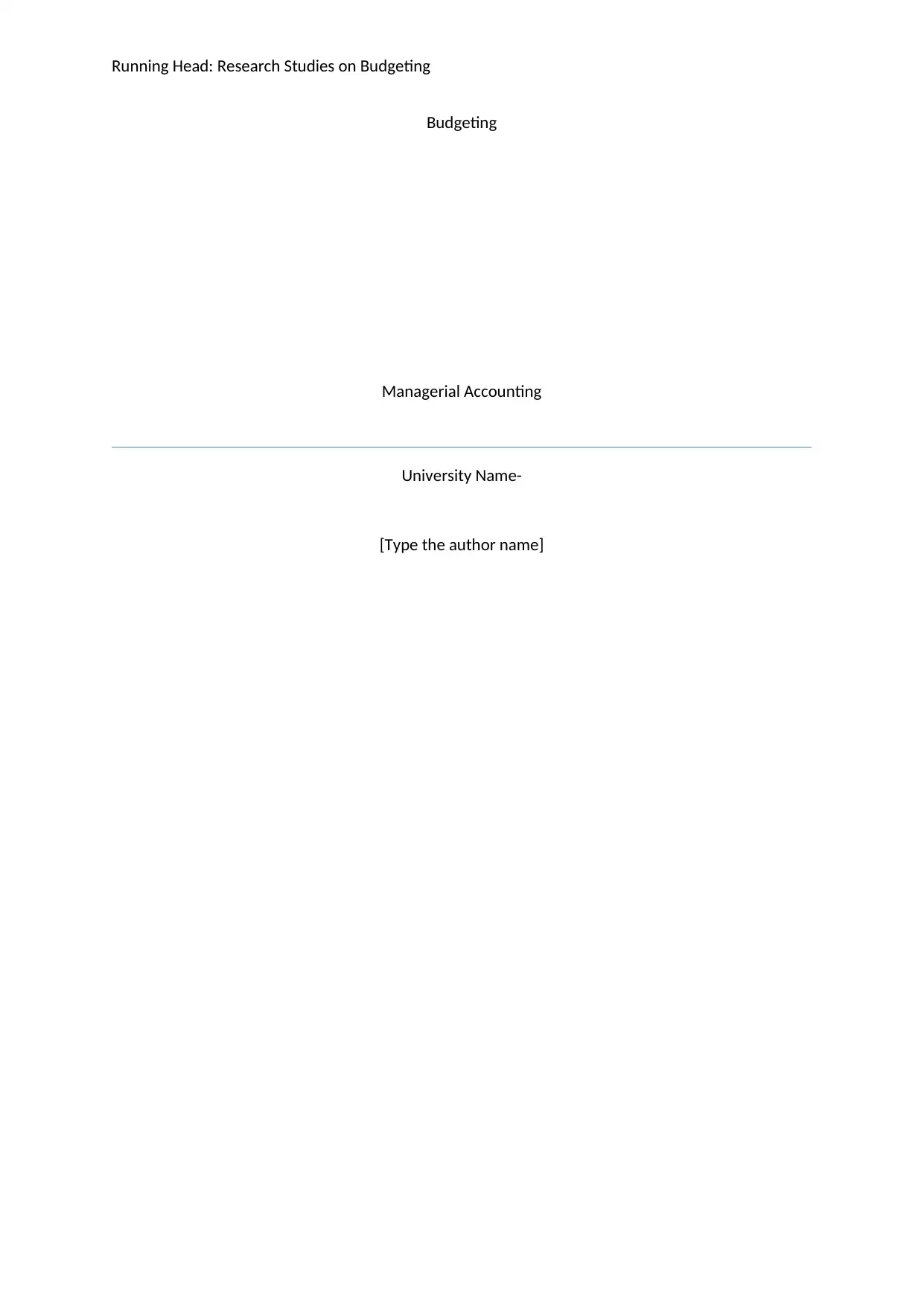
Running Head: Research Studies on Budgeting
Budgeting
Managerial Accounting
University Name-
[Type the author name]
Budgeting
Managerial Accounting
University Name-
[Type the author name]
Paraphrase This Document
Need a fresh take? Get an instant paraphrase of this document with our AI Paraphraser
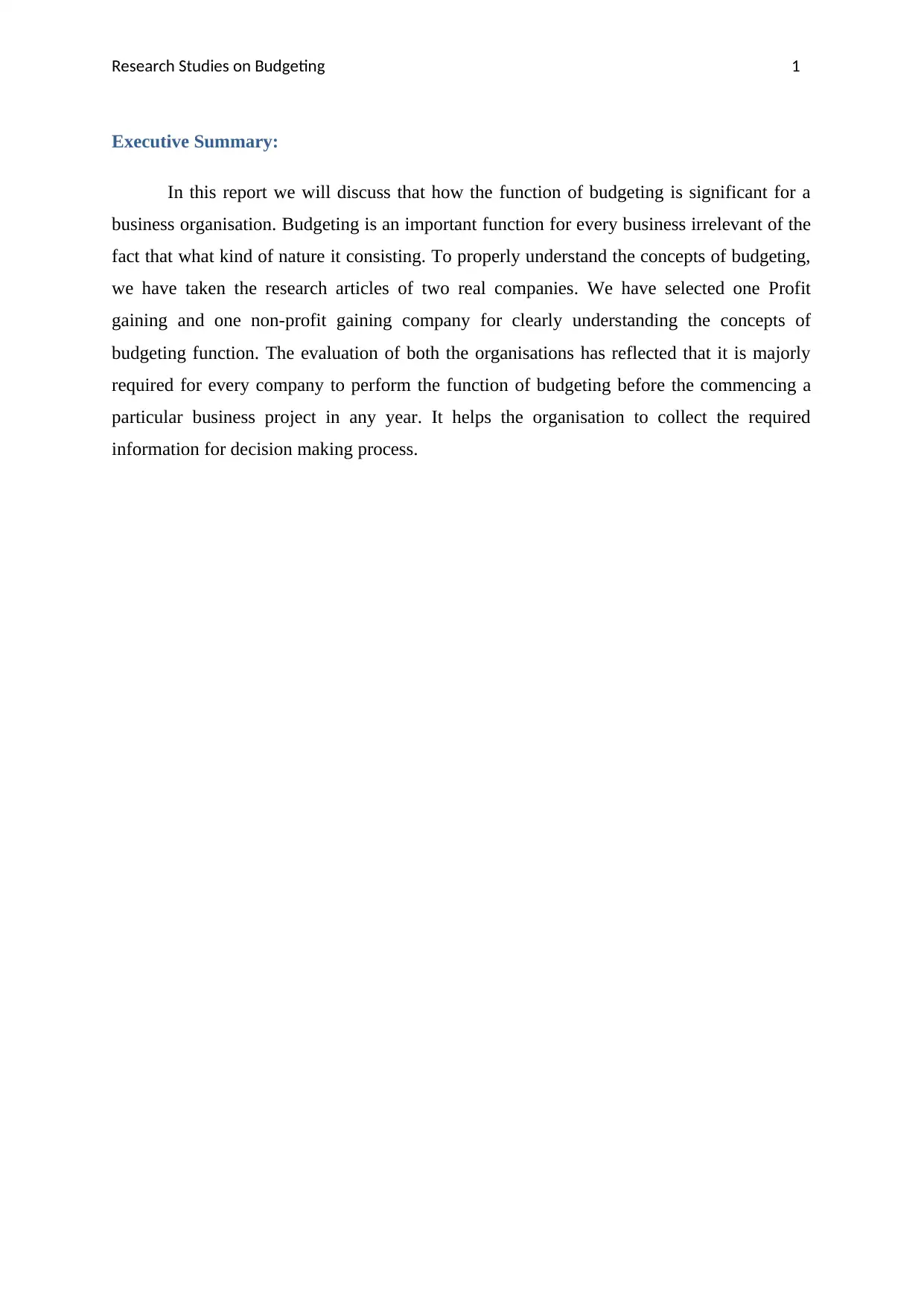
Research Studies on Budgeting 1
Executive Summary:
In this report we will discuss that how the function of budgeting is significant for a
business organisation. Budgeting is an important function for every business irrelevant of the
fact that what kind of nature it consisting. To properly understand the concepts of budgeting,
we have taken the research articles of two real companies. We have selected one Profit
gaining and one non-profit gaining company for clearly understanding the concepts of
budgeting function. The evaluation of both the organisations has reflected that it is majorly
required for every company to perform the function of budgeting before the commencing a
particular business project in any year. It helps the organisation to collect the required
information for decision making process.
Executive Summary:
In this report we will discuss that how the function of budgeting is significant for a
business organisation. Budgeting is an important function for every business irrelevant of the
fact that what kind of nature it consisting. To properly understand the concepts of budgeting,
we have taken the research articles of two real companies. We have selected one Profit
gaining and one non-profit gaining company for clearly understanding the concepts of
budgeting function. The evaluation of both the organisations has reflected that it is majorly
required for every company to perform the function of budgeting before the commencing a
particular business project in any year. It helps the organisation to collect the required
information for decision making process.
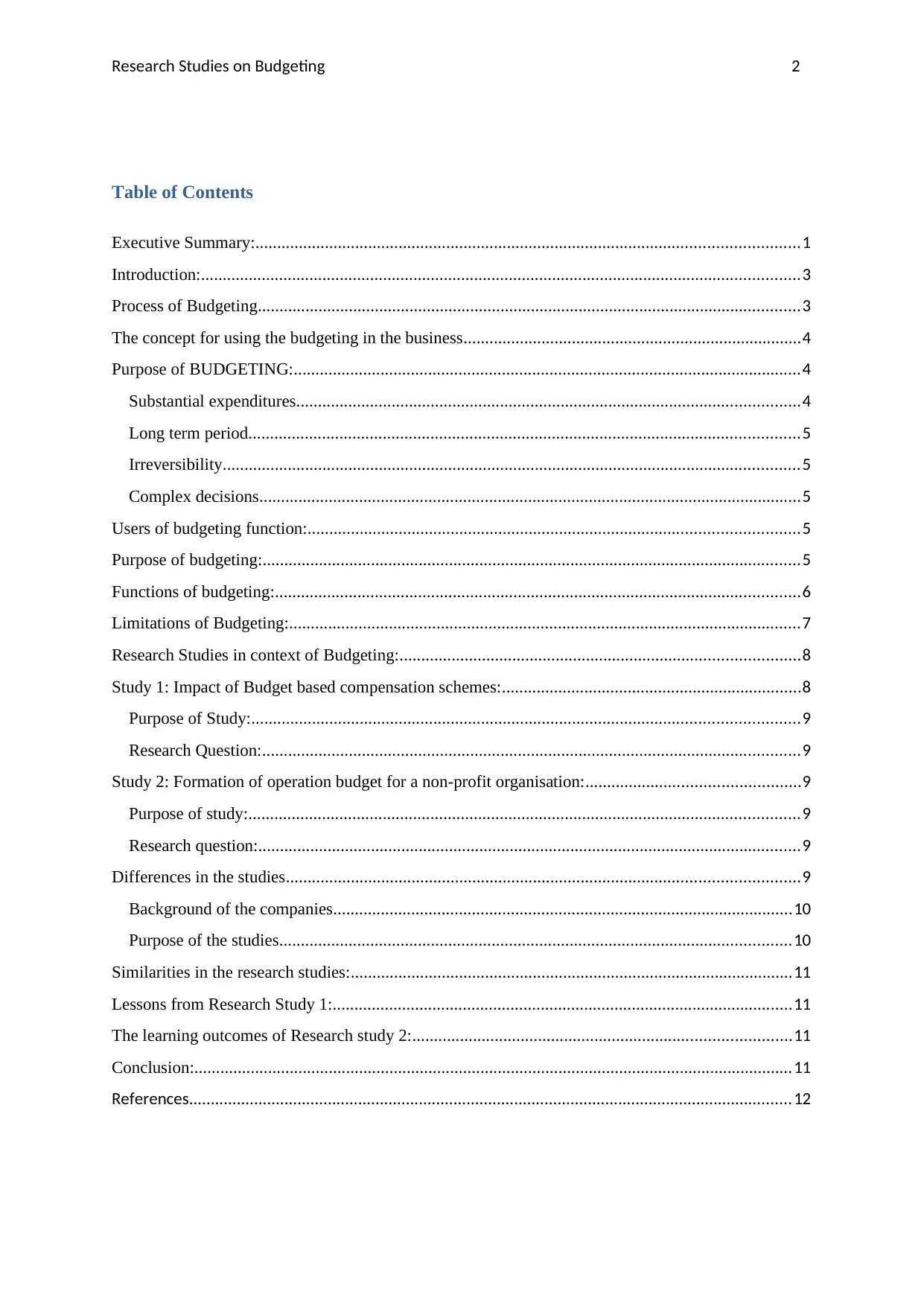
Research Studies on Budgeting 2
Table of Contents
Executive Summary:.............................................................................................................................1
Introduction:..........................................................................................................................................3
Process of Budgeting.............................................................................................................................3
The concept for using the budgeting in the business..............................................................................4
Purpose of BUDGETING:.....................................................................................................................4
Substantial expenditures....................................................................................................................4
Long term period...............................................................................................................................5
Irreversibility.....................................................................................................................................5
Complex decisions.............................................................................................................................5
Users of budgeting function:.................................................................................................................5
Purpose of budgeting:............................................................................................................................5
Functions of budgeting:.........................................................................................................................6
Limitations of Budgeting:......................................................................................................................7
Research Studies in context of Budgeting:............................................................................................8
Study 1: Impact of Budget based compensation schemes:.....................................................................8
Purpose of Study:..............................................................................................................................9
Research Question:............................................................................................................................9
Study 2: Formation of operation budget for a non-profit organisation:.................................................9
Purpose of study:...............................................................................................................................9
Research question:.............................................................................................................................9
Differences in the studies......................................................................................................................9
Background of the companies..........................................................................................................10
Purpose of the studies......................................................................................................................10
Similarities in the research studies:......................................................................................................11
Lessons from Research Study 1:..........................................................................................................11
The learning outcomes of Research study 2:.......................................................................................11
Conclusion:..........................................................................................................................................11
References...........................................................................................................................................12
Table of Contents
Executive Summary:.............................................................................................................................1
Introduction:..........................................................................................................................................3
Process of Budgeting.............................................................................................................................3
The concept for using the budgeting in the business..............................................................................4
Purpose of BUDGETING:.....................................................................................................................4
Substantial expenditures....................................................................................................................4
Long term period...............................................................................................................................5
Irreversibility.....................................................................................................................................5
Complex decisions.............................................................................................................................5
Users of budgeting function:.................................................................................................................5
Purpose of budgeting:............................................................................................................................5
Functions of budgeting:.........................................................................................................................6
Limitations of Budgeting:......................................................................................................................7
Research Studies in context of Budgeting:............................................................................................8
Study 1: Impact of Budget based compensation schemes:.....................................................................8
Purpose of Study:..............................................................................................................................9
Research Question:............................................................................................................................9
Study 2: Formation of operation budget for a non-profit organisation:.................................................9
Purpose of study:...............................................................................................................................9
Research question:.............................................................................................................................9
Differences in the studies......................................................................................................................9
Background of the companies..........................................................................................................10
Purpose of the studies......................................................................................................................10
Similarities in the research studies:......................................................................................................11
Lessons from Research Study 1:..........................................................................................................11
The learning outcomes of Research study 2:.......................................................................................11
Conclusion:..........................................................................................................................................11
References...........................................................................................................................................12
⊘ This is a preview!⊘
Do you want full access?
Subscribe today to unlock all pages.

Trusted by 1+ million students worldwide

Research Studies on Budgeting 3
Paraphrase This Document
Need a fresh take? Get an instant paraphrase of this document with our AI Paraphraser
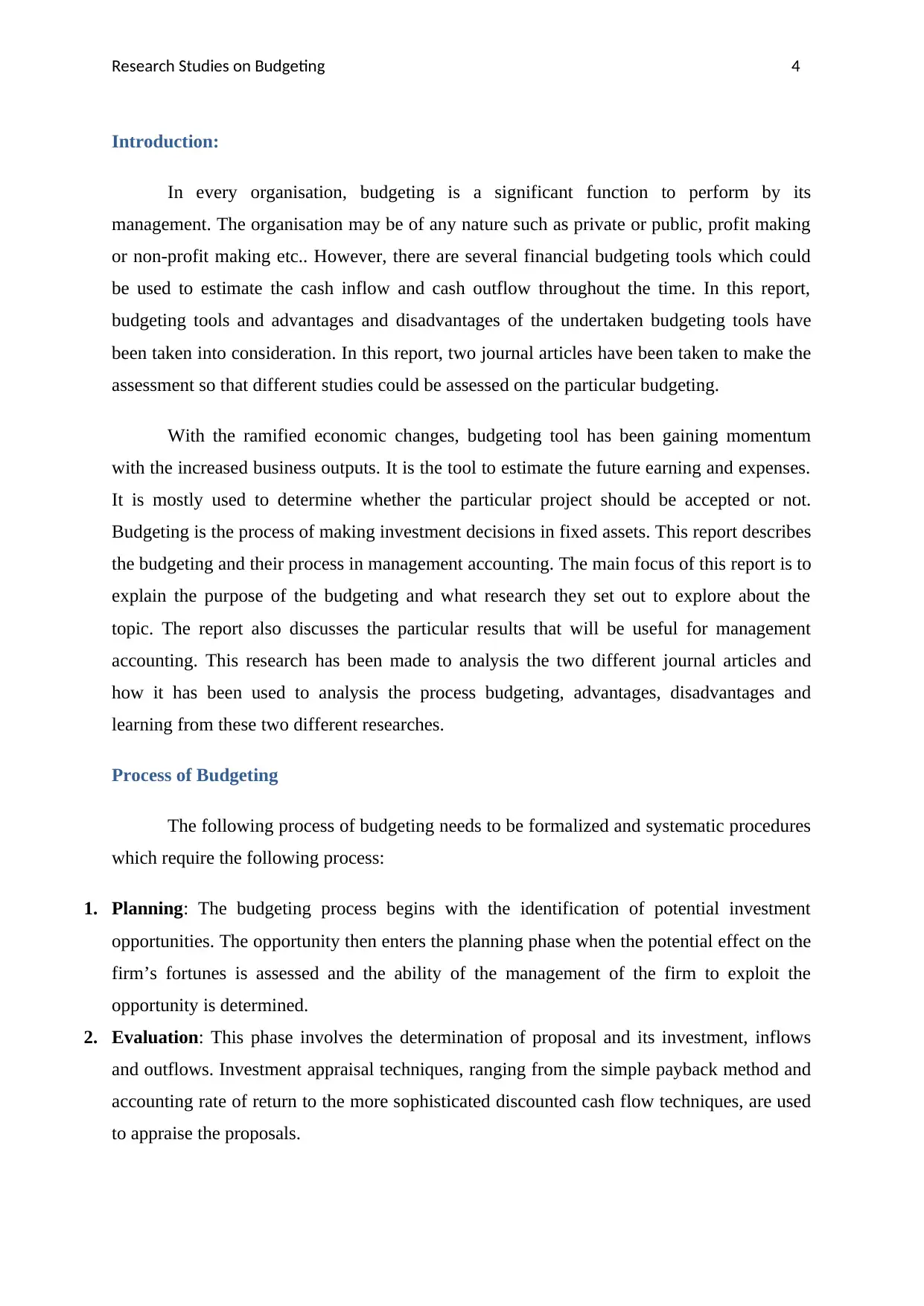
Research Studies on Budgeting 4
Introduction:
In every organisation, budgeting is a significant function to perform by its
management. The organisation may be of any nature such as private or public, profit making
or non-profit making etc.. However, there are several financial budgeting tools which could
be used to estimate the cash inflow and cash outflow throughout the time. In this report,
budgeting tools and advantages and disadvantages of the undertaken budgeting tools have
been taken into consideration. In this report, two journal articles have been taken to make the
assessment so that different studies could be assessed on the particular budgeting.
With the ramified economic changes, budgeting tool has been gaining momentum
with the increased business outputs. It is the tool to estimate the future earning and expenses.
It is mostly used to determine whether the particular project should be accepted or not.
Budgeting is the process of making investment decisions in fixed assets. This report describes
the budgeting and their process in management accounting. The main focus of this report is to
explain the purpose of the budgeting and what research they set out to explore about the
topic. The report also discusses the particular results that will be useful for management
accounting. This research has been made to analysis the two different journal articles and
how it has been used to analysis the process budgeting, advantages, disadvantages and
learning from these two different researches.
Process of Budgeting
The following process of budgeting needs to be formalized and systematic procedures
which require the following process:
1. Planning: The budgeting process begins with the identification of potential investment
opportunities. The opportunity then enters the planning phase when the potential effect on the
firm’s fortunes is assessed and the ability of the management of the firm to exploit the
opportunity is determined.
2. Evaluation: This phase involves the determination of proposal and its investment, inflows
and outflows. Investment appraisal techniques, ranging from the simple payback method and
accounting rate of return to the more sophisticated discounted cash flow techniques, are used
to appraise the proposals.
Introduction:
In every organisation, budgeting is a significant function to perform by its
management. The organisation may be of any nature such as private or public, profit making
or non-profit making etc.. However, there are several financial budgeting tools which could
be used to estimate the cash inflow and cash outflow throughout the time. In this report,
budgeting tools and advantages and disadvantages of the undertaken budgeting tools have
been taken into consideration. In this report, two journal articles have been taken to make the
assessment so that different studies could be assessed on the particular budgeting.
With the ramified economic changes, budgeting tool has been gaining momentum
with the increased business outputs. It is the tool to estimate the future earning and expenses.
It is mostly used to determine whether the particular project should be accepted or not.
Budgeting is the process of making investment decisions in fixed assets. This report describes
the budgeting and their process in management accounting. The main focus of this report is to
explain the purpose of the budgeting and what research they set out to explore about the
topic. The report also discusses the particular results that will be useful for management
accounting. This research has been made to analysis the two different journal articles and
how it has been used to analysis the process budgeting, advantages, disadvantages and
learning from these two different researches.
Process of Budgeting
The following process of budgeting needs to be formalized and systematic procedures
which require the following process:
1. Planning: The budgeting process begins with the identification of potential investment
opportunities. The opportunity then enters the planning phase when the potential effect on the
firm’s fortunes is assessed and the ability of the management of the firm to exploit the
opportunity is determined.
2. Evaluation: This phase involves the determination of proposal and its investment, inflows
and outflows. Investment appraisal techniques, ranging from the simple payback method and
accounting rate of return to the more sophisticated discounted cash flow techniques, are used
to appraise the proposals.
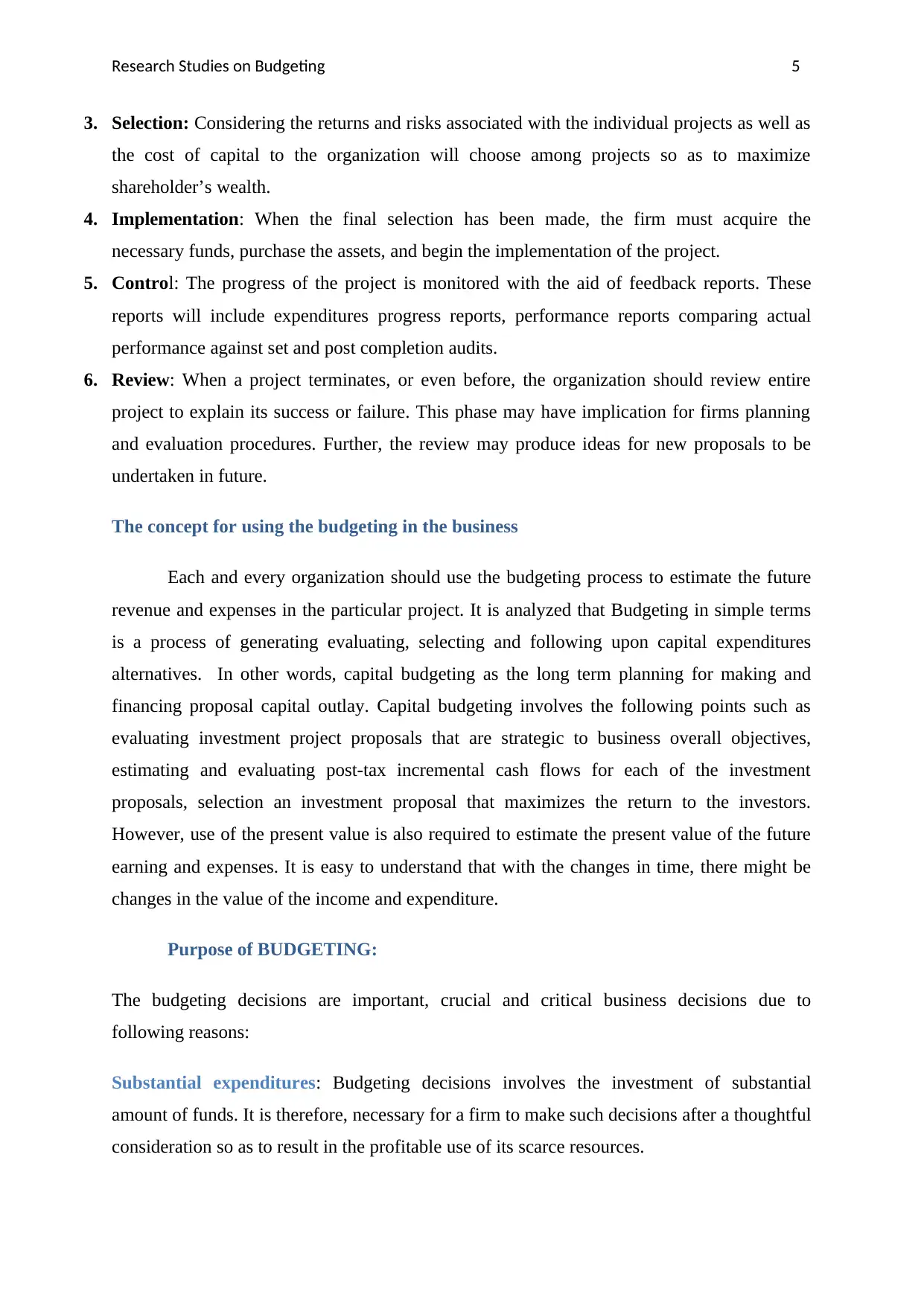
Research Studies on Budgeting 5
3. Selection: Considering the returns and risks associated with the individual projects as well as
the cost of capital to the organization will choose among projects so as to maximize
shareholder’s wealth.
4. Implementation: When the final selection has been made, the firm must acquire the
necessary funds, purchase the assets, and begin the implementation of the project.
5. Control: The progress of the project is monitored with the aid of feedback reports. These
reports will include expenditures progress reports, performance reports comparing actual
performance against set and post completion audits.
6. Review: When a project terminates, or even before, the organization should review entire
project to explain its success or failure. This phase may have implication for firms planning
and evaluation procedures. Further, the review may produce ideas for new proposals to be
undertaken in future.
The concept for using the budgeting in the business
Each and every organization should use the budgeting process to estimate the future
revenue and expenses in the particular project. It is analyzed that Budgeting in simple terms
is a process of generating evaluating, selecting and following upon capital expenditures
alternatives. In other words, capital budgeting as the long term planning for making and
financing proposal capital outlay. Capital budgeting involves the following points such as
evaluating investment project proposals that are strategic to business overall objectives,
estimating and evaluating post-tax incremental cash flows for each of the investment
proposals, selection an investment proposal that maximizes the return to the investors.
However, use of the present value is also required to estimate the present value of the future
earning and expenses. It is easy to understand that with the changes in time, there might be
changes in the value of the income and expenditure.
Purpose of BUDGETING:
The budgeting decisions are important, crucial and critical business decisions due to
following reasons:
Substantial expenditures: Budgeting decisions involves the investment of substantial
amount of funds. It is therefore, necessary for a firm to make such decisions after a thoughtful
consideration so as to result in the profitable use of its scarce resources.
3. Selection: Considering the returns and risks associated with the individual projects as well as
the cost of capital to the organization will choose among projects so as to maximize
shareholder’s wealth.
4. Implementation: When the final selection has been made, the firm must acquire the
necessary funds, purchase the assets, and begin the implementation of the project.
5. Control: The progress of the project is monitored with the aid of feedback reports. These
reports will include expenditures progress reports, performance reports comparing actual
performance against set and post completion audits.
6. Review: When a project terminates, or even before, the organization should review entire
project to explain its success or failure. This phase may have implication for firms planning
and evaluation procedures. Further, the review may produce ideas for new proposals to be
undertaken in future.
The concept for using the budgeting in the business
Each and every organization should use the budgeting process to estimate the future
revenue and expenses in the particular project. It is analyzed that Budgeting in simple terms
is a process of generating evaluating, selecting and following upon capital expenditures
alternatives. In other words, capital budgeting as the long term planning for making and
financing proposal capital outlay. Capital budgeting involves the following points such as
evaluating investment project proposals that are strategic to business overall objectives,
estimating and evaluating post-tax incremental cash flows for each of the investment
proposals, selection an investment proposal that maximizes the return to the investors.
However, use of the present value is also required to estimate the present value of the future
earning and expenses. It is easy to understand that with the changes in time, there might be
changes in the value of the income and expenditure.
Purpose of BUDGETING:
The budgeting decisions are important, crucial and critical business decisions due to
following reasons:
Substantial expenditures: Budgeting decisions involves the investment of substantial
amount of funds. It is therefore, necessary for a firm to make such decisions after a thoughtful
consideration so as to result in the profitable use of its scarce resources.
⊘ This is a preview!⊘
Do you want full access?
Subscribe today to unlock all pages.

Trusted by 1+ million students worldwide
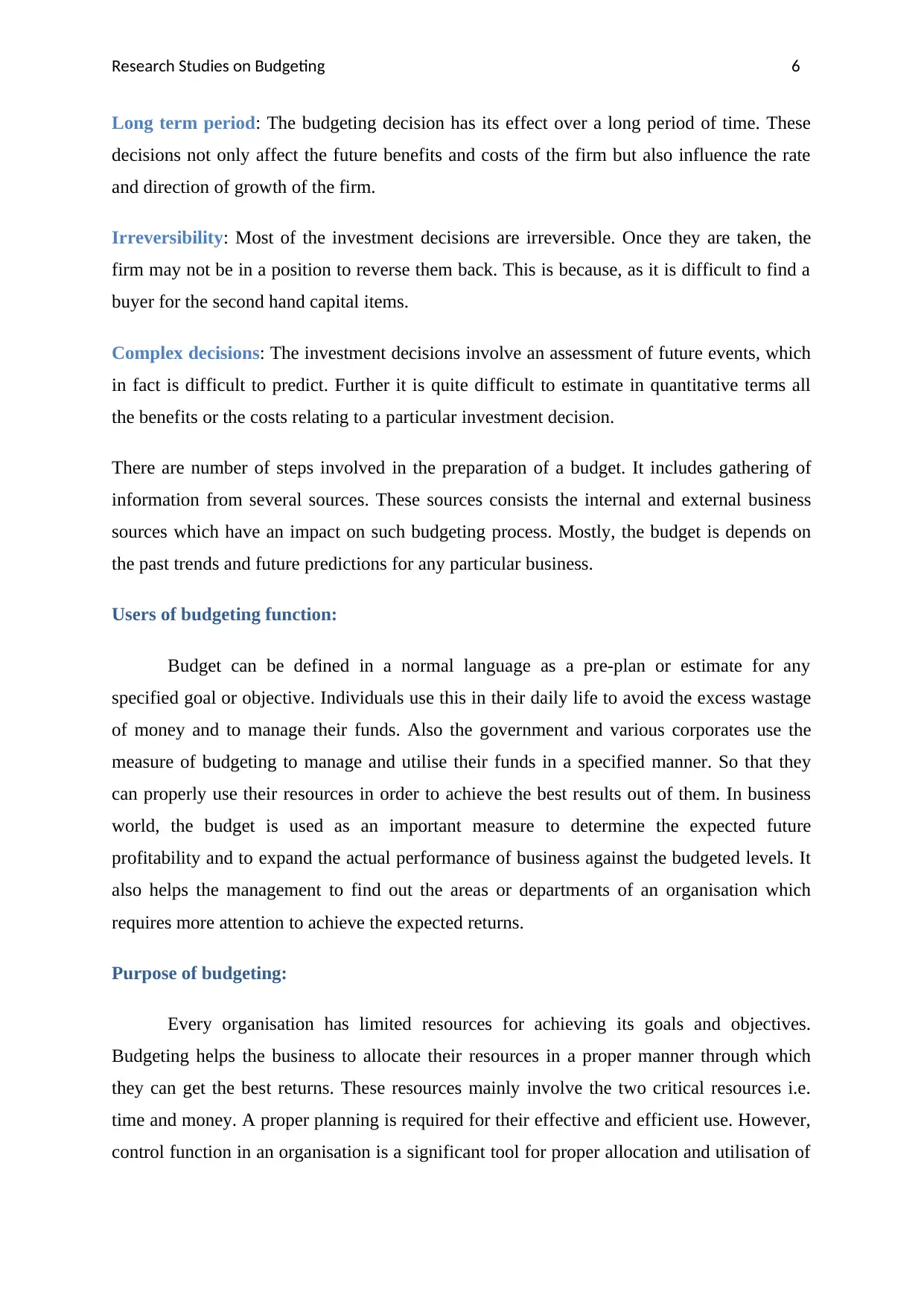
Research Studies on Budgeting 6
Long term period: The budgeting decision has its effect over a long period of time. These
decisions not only affect the future benefits and costs of the firm but also influence the rate
and direction of growth of the firm.
Irreversibility: Most of the investment decisions are irreversible. Once they are taken, the
firm may not be in a position to reverse them back. This is because, as it is difficult to find a
buyer for the second hand capital items.
Complex decisions: The investment decisions involve an assessment of future events, which
in fact is difficult to predict. Further it is quite difficult to estimate in quantitative terms all
the benefits or the costs relating to a particular investment decision.
There are number of steps involved in the preparation of a budget. It includes gathering of
information from several sources. These sources consists the internal and external business
sources which have an impact on such budgeting process. Mostly, the budget is depends on
the past trends and future predictions for any particular business.
Users of budgeting function:
Budget can be defined in a normal language as a pre-plan or estimate for any
specified goal or objective. Individuals use this in their daily life to avoid the excess wastage
of money and to manage their funds. Also the government and various corporates use the
measure of budgeting to manage and utilise their funds in a specified manner. So that they
can properly use their resources in order to achieve the best results out of them. In business
world, the budget is used as an important measure to determine the expected future
profitability and to expand the actual performance of business against the budgeted levels. It
also helps the management to find out the areas or departments of an organisation which
requires more attention to achieve the expected returns.
Purpose of budgeting:
Every organisation has limited resources for achieving its goals and objectives.
Budgeting helps the business to allocate their resources in a proper manner through which
they can get the best returns. These resources mainly involve the two critical resources i.e.
time and money. A proper planning is required for their effective and efficient use. However,
control function in an organisation is a significant tool for proper allocation and utilisation of
Long term period: The budgeting decision has its effect over a long period of time. These
decisions not only affect the future benefits and costs of the firm but also influence the rate
and direction of growth of the firm.
Irreversibility: Most of the investment decisions are irreversible. Once they are taken, the
firm may not be in a position to reverse them back. This is because, as it is difficult to find a
buyer for the second hand capital items.
Complex decisions: The investment decisions involve an assessment of future events, which
in fact is difficult to predict. Further it is quite difficult to estimate in quantitative terms all
the benefits or the costs relating to a particular investment decision.
There are number of steps involved in the preparation of a budget. It includes gathering of
information from several sources. These sources consists the internal and external business
sources which have an impact on such budgeting process. Mostly, the budget is depends on
the past trends and future predictions for any particular business.
Users of budgeting function:
Budget can be defined in a normal language as a pre-plan or estimate for any
specified goal or objective. Individuals use this in their daily life to avoid the excess wastage
of money and to manage their funds. Also the government and various corporates use the
measure of budgeting to manage and utilise their funds in a specified manner. So that they
can properly use their resources in order to achieve the best results out of them. In business
world, the budget is used as an important measure to determine the expected future
profitability and to expand the actual performance of business against the budgeted levels. It
also helps the management to find out the areas or departments of an organisation which
requires more attention to achieve the expected returns.
Purpose of budgeting:
Every organisation has limited resources for achieving its goals and objectives.
Budgeting helps the business to allocate their resources in a proper manner through which
they can get the best returns. These resources mainly involve the two critical resources i.e.
time and money. A proper planning is required for their effective and efficient use. However,
control function in an organisation is a significant tool for proper allocation and utilisation of
Paraphrase This Document
Need a fresh take? Get an instant paraphrase of this document with our AI Paraphraser
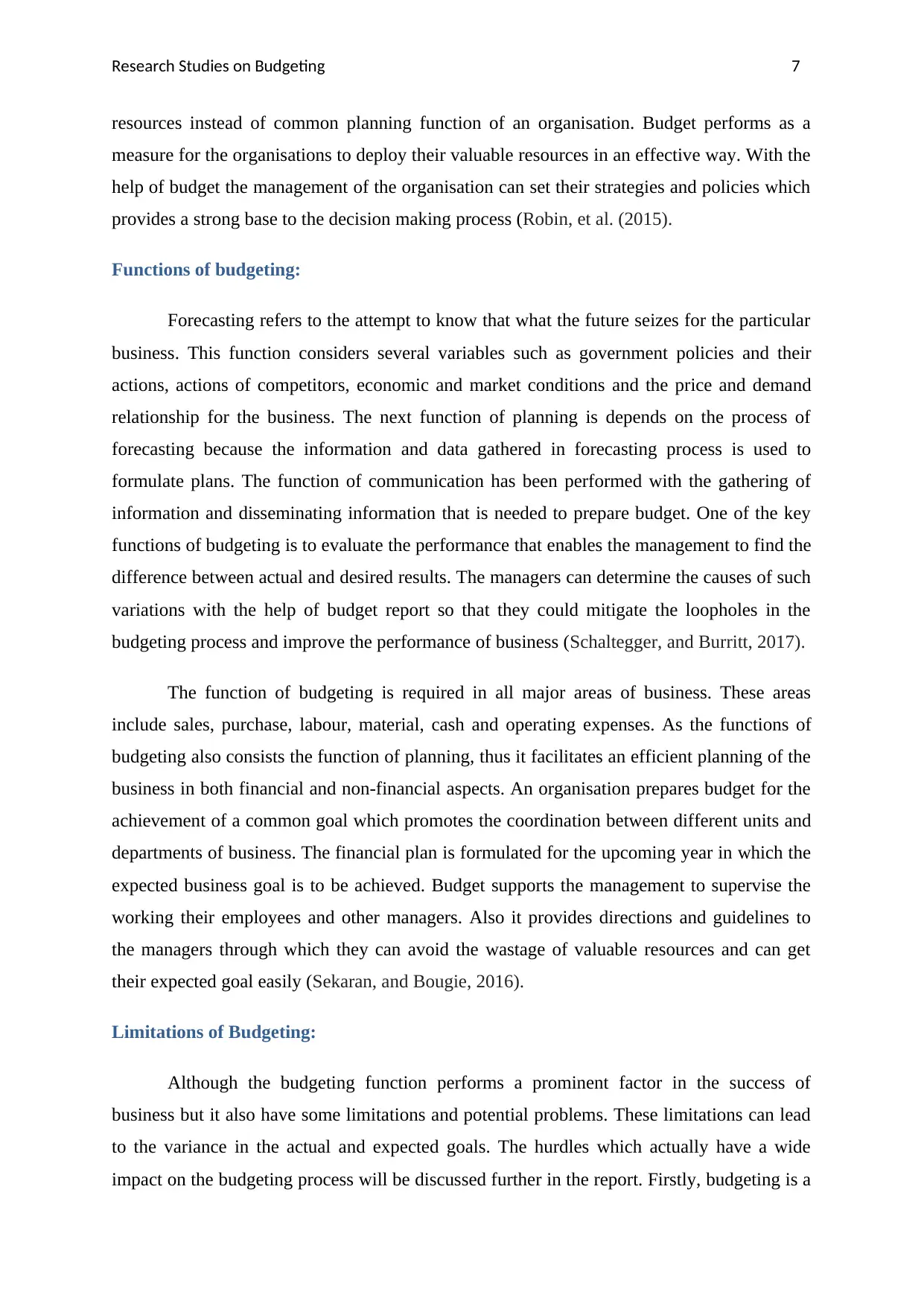
Research Studies on Budgeting 7
resources instead of common planning function of an organisation. Budget performs as a
measure for the organisations to deploy their valuable resources in an effective way. With the
help of budget the management of the organisation can set their strategies and policies which
provides a strong base to the decision making process (Robin, et al. (2015).
Functions of budgeting:
Forecasting refers to the attempt to know that what the future seizes for the particular
business. This function considers several variables such as government policies and their
actions, actions of competitors, economic and market conditions and the price and demand
relationship for the business. The next function of planning is depends on the process of
forecasting because the information and data gathered in forecasting process is used to
formulate plans. The function of communication has been performed with the gathering of
information and disseminating information that is needed to prepare budget. One of the key
functions of budgeting is to evaluate the performance that enables the management to find the
difference between actual and desired results. The managers can determine the causes of such
variations with the help of budget report so that they could mitigate the loopholes in the
budgeting process and improve the performance of business (Schaltegger, and Burritt, 2017).
The function of budgeting is required in all major areas of business. These areas
include sales, purchase, labour, material, cash and operating expenses. As the functions of
budgeting also consists the function of planning, thus it facilitates an efficient planning of the
business in both financial and non-financial aspects. An organisation prepares budget for the
achievement of a common goal which promotes the coordination between different units and
departments of business. The financial plan is formulated for the upcoming year in which the
expected business goal is to be achieved. Budget supports the management to supervise the
working their employees and other managers. Also it provides directions and guidelines to
the managers through which they can avoid the wastage of valuable resources and can get
their expected goal easily (Sekaran, and Bougie, 2016).
Limitations of Budgeting:
Although the budgeting function performs a prominent factor in the success of
business but it also have some limitations and potential problems. These limitations can lead
to the variance in the actual and expected goals. The hurdles which actually have a wide
impact on the budgeting process will be discussed further in the report. Firstly, budgeting is a
resources instead of common planning function of an organisation. Budget performs as a
measure for the organisations to deploy their valuable resources in an effective way. With the
help of budget the management of the organisation can set their strategies and policies which
provides a strong base to the decision making process (Robin, et al. (2015).
Functions of budgeting:
Forecasting refers to the attempt to know that what the future seizes for the particular
business. This function considers several variables such as government policies and their
actions, actions of competitors, economic and market conditions and the price and demand
relationship for the business. The next function of planning is depends on the process of
forecasting because the information and data gathered in forecasting process is used to
formulate plans. The function of communication has been performed with the gathering of
information and disseminating information that is needed to prepare budget. One of the key
functions of budgeting is to evaluate the performance that enables the management to find the
difference between actual and desired results. The managers can determine the causes of such
variations with the help of budget report so that they could mitigate the loopholes in the
budgeting process and improve the performance of business (Schaltegger, and Burritt, 2017).
The function of budgeting is required in all major areas of business. These areas
include sales, purchase, labour, material, cash and operating expenses. As the functions of
budgeting also consists the function of planning, thus it facilitates an efficient planning of the
business in both financial and non-financial aspects. An organisation prepares budget for the
achievement of a common goal which promotes the coordination between different units and
departments of business. The financial plan is formulated for the upcoming year in which the
expected business goal is to be achieved. Budget supports the management to supervise the
working their employees and other managers. Also it provides directions and guidelines to
the managers through which they can avoid the wastage of valuable resources and can get
their expected goal easily (Sekaran, and Bougie, 2016).
Limitations of Budgeting:
Although the budgeting function performs a prominent factor in the success of
business but it also have some limitations and potential problems. These limitations can lead
to the variance in the actual and expected goals. The hurdles which actually have a wide
impact on the budgeting process will be discussed further in the report. Firstly, budgeting is a
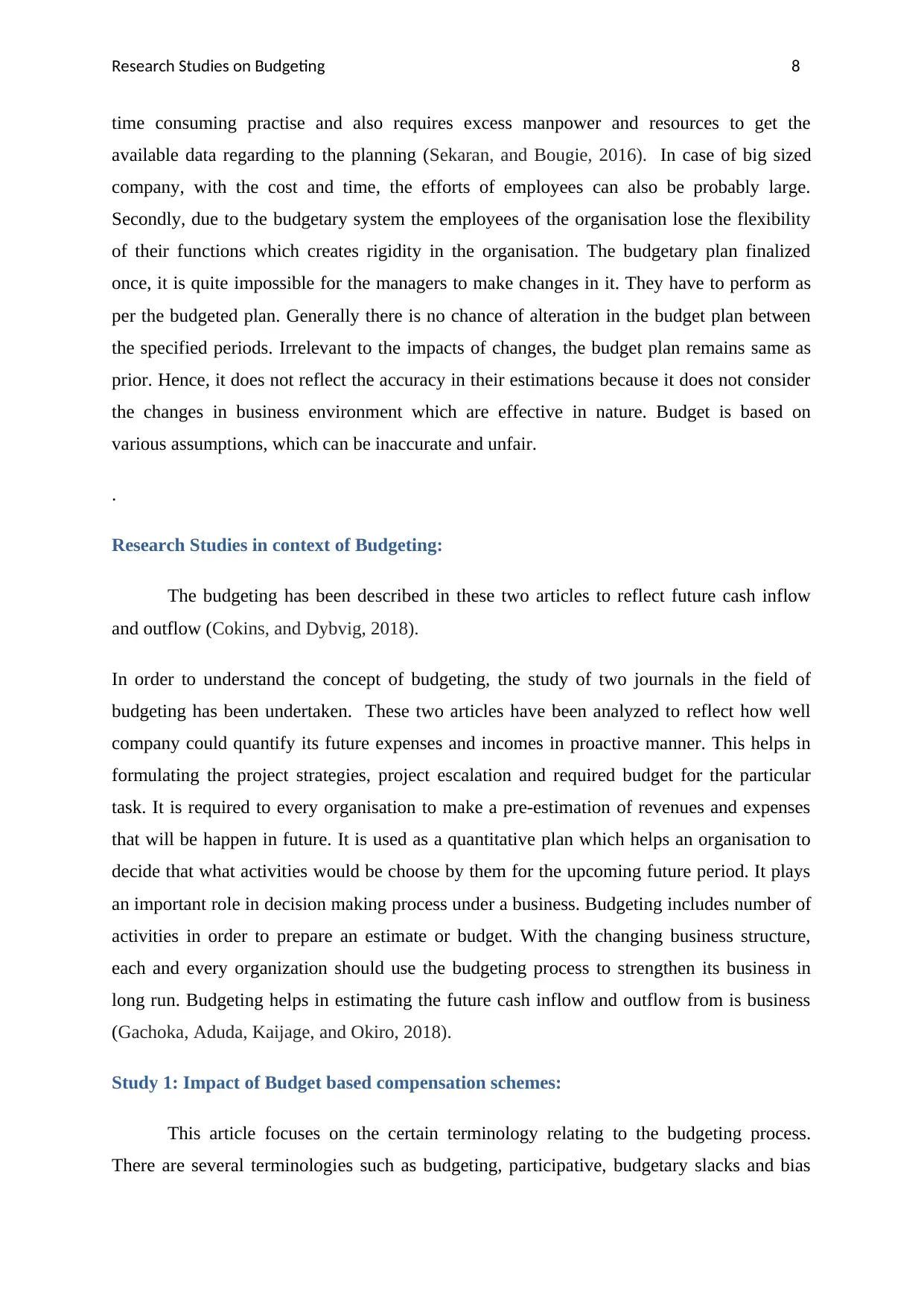
Research Studies on Budgeting 8
time consuming practise and also requires excess manpower and resources to get the
available data regarding to the planning (Sekaran, and Bougie, 2016). In case of big sized
company, with the cost and time, the efforts of employees can also be probably large.
Secondly, due to the budgetary system the employees of the organisation lose the flexibility
of their functions which creates rigidity in the organisation. The budgetary plan finalized
once, it is quite impossible for the managers to make changes in it. They have to perform as
per the budgeted plan. Generally there is no chance of alteration in the budget plan between
the specified periods. Irrelevant to the impacts of changes, the budget plan remains same as
prior. Hence, it does not reflect the accuracy in their estimations because it does not consider
the changes in business environment which are effective in nature. Budget is based on
various assumptions, which can be inaccurate and unfair.
.
Research Studies in context of Budgeting:
The budgeting has been described in these two articles to reflect future cash inflow
and outflow (Cokins, and Dybvig, 2018).
In order to understand the concept of budgeting, the study of two journals in the field of
budgeting has been undertaken. These two articles have been analyzed to reflect how well
company could quantify its future expenses and incomes in proactive manner. This helps in
formulating the project strategies, project escalation and required budget for the particular
task. It is required to every organisation to make a pre-estimation of revenues and expenses
that will be happen in future. It is used as a quantitative plan which helps an organisation to
decide that what activities would be choose by them for the upcoming future period. It plays
an important role in decision making process under a business. Budgeting includes number of
activities in order to prepare an estimate or budget. With the changing business structure,
each and every organization should use the budgeting process to strengthen its business in
long run. Budgeting helps in estimating the future cash inflow and outflow from is business
(Gachoka, Aduda, Kaijage, and Okiro, 2018).
Study 1: Impact of Budget based compensation schemes:
This article focuses on the certain terminology relating to the budgeting process.
There are several terminologies such as budgeting, participative, budgetary slacks and bias
time consuming practise and also requires excess manpower and resources to get the
available data regarding to the planning (Sekaran, and Bougie, 2016). In case of big sized
company, with the cost and time, the efforts of employees can also be probably large.
Secondly, due to the budgetary system the employees of the organisation lose the flexibility
of their functions which creates rigidity in the organisation. The budgetary plan finalized
once, it is quite impossible for the managers to make changes in it. They have to perform as
per the budgeted plan. Generally there is no chance of alteration in the budget plan between
the specified periods. Irrelevant to the impacts of changes, the budget plan remains same as
prior. Hence, it does not reflect the accuracy in their estimations because it does not consider
the changes in business environment which are effective in nature. Budget is based on
various assumptions, which can be inaccurate and unfair.
.
Research Studies in context of Budgeting:
The budgeting has been described in these two articles to reflect future cash inflow
and outflow (Cokins, and Dybvig, 2018).
In order to understand the concept of budgeting, the study of two journals in the field of
budgeting has been undertaken. These two articles have been analyzed to reflect how well
company could quantify its future expenses and incomes in proactive manner. This helps in
formulating the project strategies, project escalation and required budget for the particular
task. It is required to every organisation to make a pre-estimation of revenues and expenses
that will be happen in future. It is used as a quantitative plan which helps an organisation to
decide that what activities would be choose by them for the upcoming future period. It plays
an important role in decision making process under a business. Budgeting includes number of
activities in order to prepare an estimate or budget. With the changing business structure,
each and every organization should use the budgeting process to strengthen its business in
long run. Budgeting helps in estimating the future cash inflow and outflow from is business
(Gachoka, Aduda, Kaijage, and Okiro, 2018).
Study 1: Impact of Budget based compensation schemes:
This article focuses on the certain terminology relating to the budgeting process.
There are several terminologies such as budgeting, participative, budgetary slacks and bias
⊘ This is a preview!⊘
Do you want full access?
Subscribe today to unlock all pages.

Trusted by 1+ million students worldwide
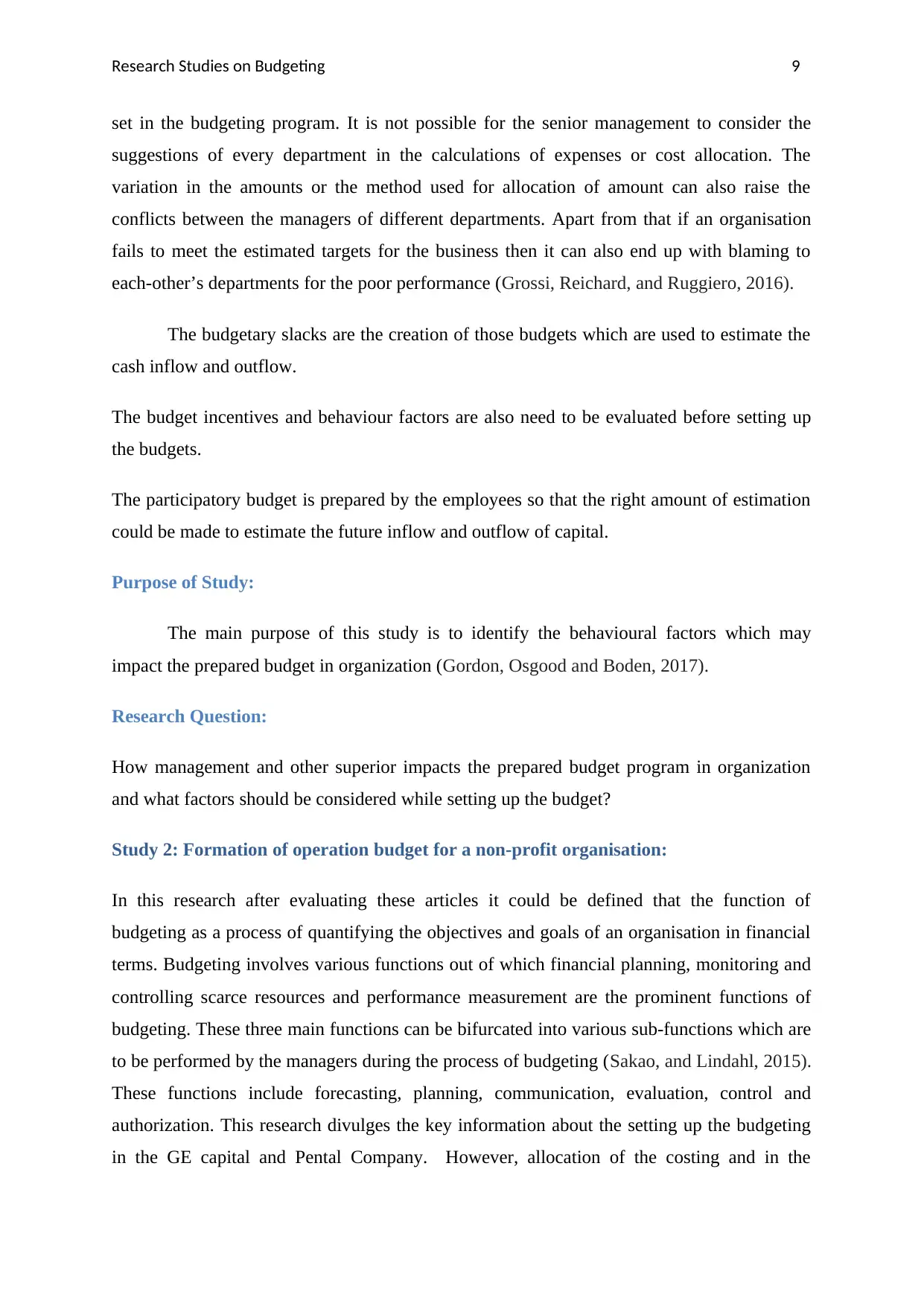
Research Studies on Budgeting 9
set in the budgeting program. It is not possible for the senior management to consider the
suggestions of every department in the calculations of expenses or cost allocation. The
variation in the amounts or the method used for allocation of amount can also raise the
conflicts between the managers of different departments. Apart from that if an organisation
fails to meet the estimated targets for the business then it can also end up with blaming to
each-other’s departments for the poor performance (Grossi, Reichard, and Ruggiero, 2016).
The budgetary slacks are the creation of those budgets which are used to estimate the
cash inflow and outflow.
The budget incentives and behaviour factors are also need to be evaluated before setting up
the budgets.
The participatory budget is prepared by the employees so that the right amount of estimation
could be made to estimate the future inflow and outflow of capital.
Purpose of Study:
The main purpose of this study is to identify the behavioural factors which may
impact the prepared budget in organization (Gordon, Osgood and Boden, 2017).
Research Question:
How management and other superior impacts the prepared budget program in organization
and what factors should be considered while setting up the budget?
Study 2: Formation of operation budget for a non-profit organisation:
In this research after evaluating these articles it could be defined that the function of
budgeting as a process of quantifying the objectives and goals of an organisation in financial
terms. Budgeting involves various functions out of which financial planning, monitoring and
controlling scarce resources and performance measurement are the prominent functions of
budgeting. These three main functions can be bifurcated into various sub-functions which are
to be performed by the managers during the process of budgeting (Sakao, and Lindahl, 2015).
These functions include forecasting, planning, communication, evaluation, control and
authorization. This research divulges the key information about the setting up the budgeting
in the GE capital and Pental Company. However, allocation of the costing and in the
set in the budgeting program. It is not possible for the senior management to consider the
suggestions of every department in the calculations of expenses or cost allocation. The
variation in the amounts or the method used for allocation of amount can also raise the
conflicts between the managers of different departments. Apart from that if an organisation
fails to meet the estimated targets for the business then it can also end up with blaming to
each-other’s departments for the poor performance (Grossi, Reichard, and Ruggiero, 2016).
The budgetary slacks are the creation of those budgets which are used to estimate the
cash inflow and outflow.
The budget incentives and behaviour factors are also need to be evaluated before setting up
the budgets.
The participatory budget is prepared by the employees so that the right amount of estimation
could be made to estimate the future inflow and outflow of capital.
Purpose of Study:
The main purpose of this study is to identify the behavioural factors which may
impact the prepared budget in organization (Gordon, Osgood and Boden, 2017).
Research Question:
How management and other superior impacts the prepared budget program in organization
and what factors should be considered while setting up the budget?
Study 2: Formation of operation budget for a non-profit organisation:
In this research after evaluating these articles it could be defined that the function of
budgeting as a process of quantifying the objectives and goals of an organisation in financial
terms. Budgeting involves various functions out of which financial planning, monitoring and
controlling scarce resources and performance measurement are the prominent functions of
budgeting. These three main functions can be bifurcated into various sub-functions which are
to be performed by the managers during the process of budgeting (Sakao, and Lindahl, 2015).
These functions include forecasting, planning, communication, evaluation, control and
authorization. This research divulges the key information about the setting up the budgeting
in the GE capital and Pental Company. However, allocation of the costing and in the
Paraphrase This Document
Need a fresh take? Get an instant paraphrase of this document with our AI Paraphraser
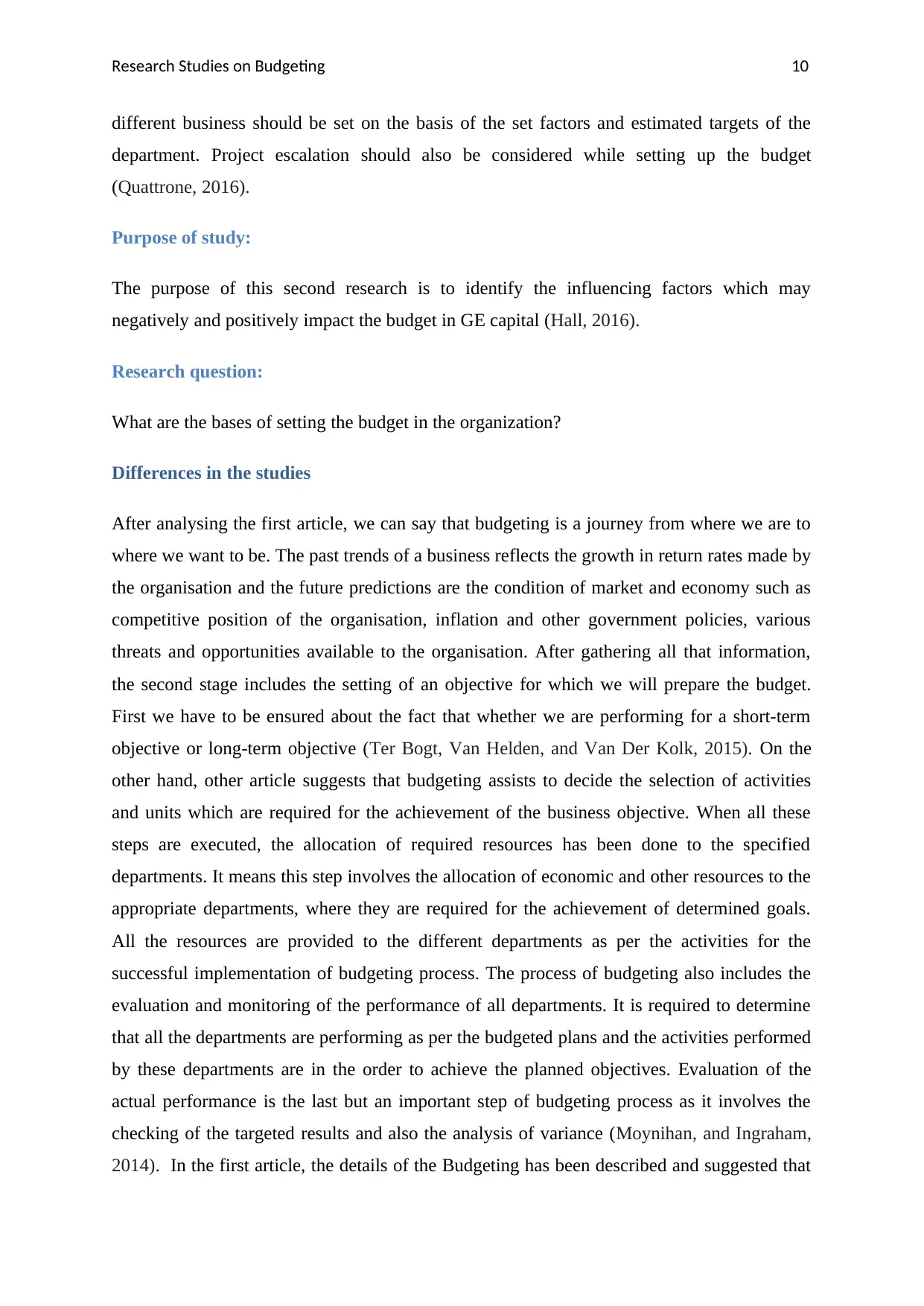
Research Studies on Budgeting 10
different business should be set on the basis of the set factors and estimated targets of the
department. Project escalation should also be considered while setting up the budget
(Quattrone, 2016).
Purpose of study:
The purpose of this second research is to identify the influencing factors which may
negatively and positively impact the budget in GE capital (Hall, 2016).
Research question:
What are the bases of setting the budget in the organization?
Differences in the studies
After analysing the first article, we can say that budgeting is a journey from where we are to
where we want to be. The past trends of a business reflects the growth in return rates made by
the organisation and the future predictions are the condition of market and economy such as
competitive position of the organisation, inflation and other government policies, various
threats and opportunities available to the organisation. After gathering all that information,
the second stage includes the setting of an objective for which we will prepare the budget.
First we have to be ensured about the fact that whether we are performing for a short-term
objective or long-term objective (Ter Bogt, Van Helden, and Van Der Kolk, 2015). On the
other hand, other article suggests that budgeting assists to decide the selection of activities
and units which are required for the achievement of the business objective. When all these
steps are executed, the allocation of required resources has been done to the specified
departments. It means this step involves the allocation of economic and other resources to the
appropriate departments, where they are required for the achievement of determined goals.
All the resources are provided to the different departments as per the activities for the
successful implementation of budgeting process. The process of budgeting also includes the
evaluation and monitoring of the performance of all departments. It is required to determine
that all the departments are performing as per the budgeted plans and the activities performed
by these departments are in the order to achieve the planned objectives. Evaluation of the
actual performance is the last but an important step of budgeting process as it involves the
checking of the targeted results and also the analysis of variance (Moynihan, and Ingraham,
2014). In the first article, the details of the Budgeting has been described and suggested that
different business should be set on the basis of the set factors and estimated targets of the
department. Project escalation should also be considered while setting up the budget
(Quattrone, 2016).
Purpose of study:
The purpose of this second research is to identify the influencing factors which may
negatively and positively impact the budget in GE capital (Hall, 2016).
Research question:
What are the bases of setting the budget in the organization?
Differences in the studies
After analysing the first article, we can say that budgeting is a journey from where we are to
where we want to be. The past trends of a business reflects the growth in return rates made by
the organisation and the future predictions are the condition of market and economy such as
competitive position of the organisation, inflation and other government policies, various
threats and opportunities available to the organisation. After gathering all that information,
the second stage includes the setting of an objective for which we will prepare the budget.
First we have to be ensured about the fact that whether we are performing for a short-term
objective or long-term objective (Ter Bogt, Van Helden, and Van Der Kolk, 2015). On the
other hand, other article suggests that budgeting assists to decide the selection of activities
and units which are required for the achievement of the business objective. When all these
steps are executed, the allocation of required resources has been done to the specified
departments. It means this step involves the allocation of economic and other resources to the
appropriate departments, where they are required for the achievement of determined goals.
All the resources are provided to the different departments as per the activities for the
successful implementation of budgeting process. The process of budgeting also includes the
evaluation and monitoring of the performance of all departments. It is required to determine
that all the departments are performing as per the budgeted plans and the activities performed
by these departments are in the order to achieve the planned objectives. Evaluation of the
actual performance is the last but an important step of budgeting process as it involves the
checking of the targeted results and also the analysis of variance (Moynihan, and Ingraham,
2014). In the first article, the details of the Budgeting has been described and suggested that
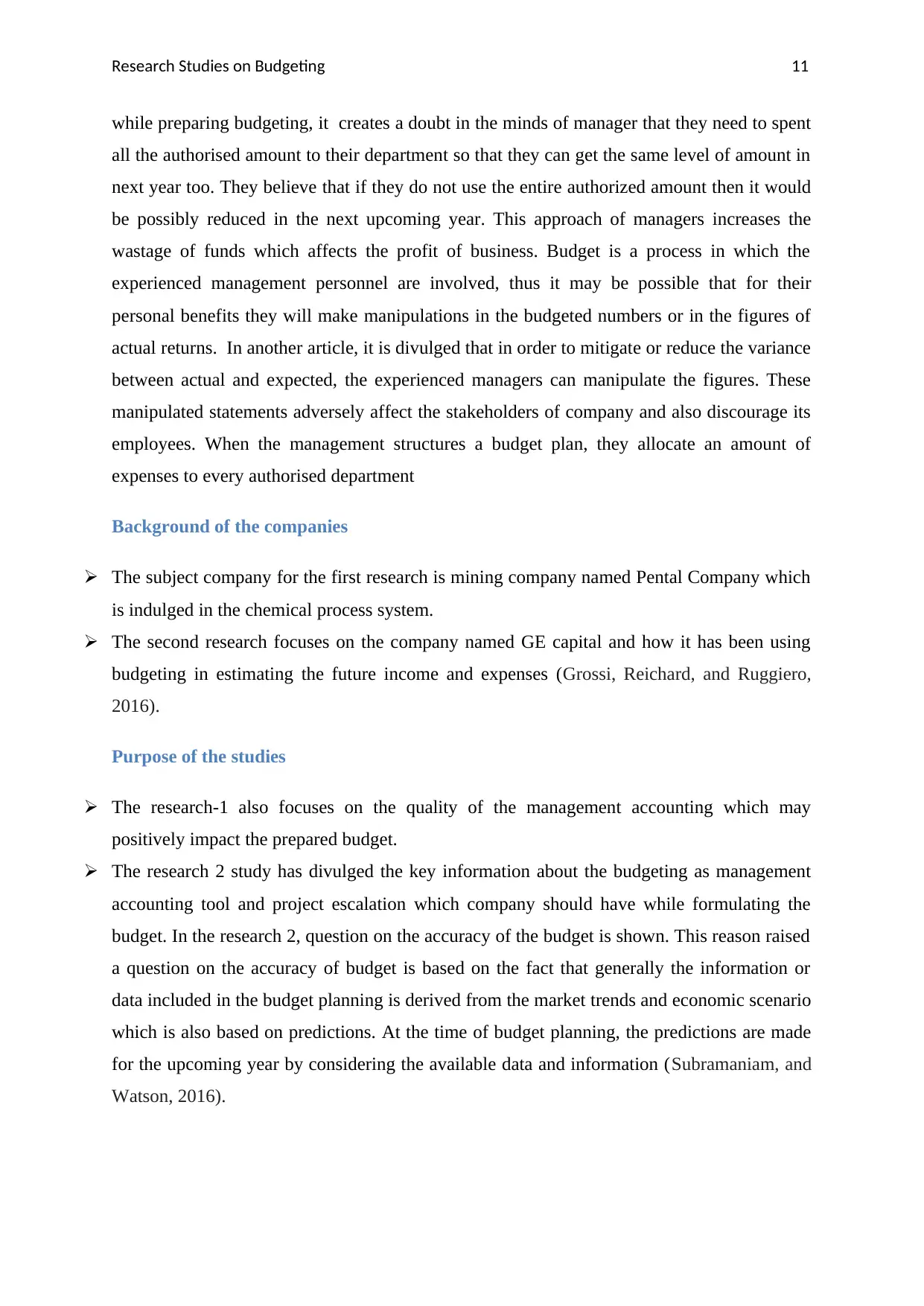
Research Studies on Budgeting 11
while preparing budgeting, it creates a doubt in the minds of manager that they need to spent
all the authorised amount to their department so that they can get the same level of amount in
next year too. They believe that if they do not use the entire authorized amount then it would
be possibly reduced in the next upcoming year. This approach of managers increases the
wastage of funds which affects the profit of business. Budget is a process in which the
experienced management personnel are involved, thus it may be possible that for their
personal benefits they will make manipulations in the budgeted numbers or in the figures of
actual returns. In another article, it is divulged that in order to mitigate or reduce the variance
between actual and expected, the experienced managers can manipulate the figures. These
manipulated statements adversely affect the stakeholders of company and also discourage its
employees. When the management structures a budget plan, they allocate an amount of
expenses to every authorised department
Background of the companies
The subject company for the first research is mining company named Pental Company which
is indulged in the chemical process system.
The second research focuses on the company named GE capital and how it has been using
budgeting in estimating the future income and expenses (Grossi, Reichard, and Ruggiero,
2016).
Purpose of the studies
The research-1 also focuses on the quality of the management accounting which may
positively impact the prepared budget.
The research 2 study has divulged the key information about the budgeting as management
accounting tool and project escalation which company should have while formulating the
budget. In the research 2, question on the accuracy of the budget is shown. This reason raised
a question on the accuracy of budget is based on the fact that generally the information or
data included in the budget planning is derived from the market trends and economic scenario
which is also based on predictions. At the time of budget planning, the predictions are made
for the upcoming year by considering the available data and information (Subramaniam, and
Watson, 2016).
while preparing budgeting, it creates a doubt in the minds of manager that they need to spent
all the authorised amount to their department so that they can get the same level of amount in
next year too. They believe that if they do not use the entire authorized amount then it would
be possibly reduced in the next upcoming year. This approach of managers increases the
wastage of funds which affects the profit of business. Budget is a process in which the
experienced management personnel are involved, thus it may be possible that for their
personal benefits they will make manipulations in the budgeted numbers or in the figures of
actual returns. In another article, it is divulged that in order to mitigate or reduce the variance
between actual and expected, the experienced managers can manipulate the figures. These
manipulated statements adversely affect the stakeholders of company and also discourage its
employees. When the management structures a budget plan, they allocate an amount of
expenses to every authorised department
Background of the companies
The subject company for the first research is mining company named Pental Company which
is indulged in the chemical process system.
The second research focuses on the company named GE capital and how it has been using
budgeting in estimating the future income and expenses (Grossi, Reichard, and Ruggiero,
2016).
Purpose of the studies
The research-1 also focuses on the quality of the management accounting which may
positively impact the prepared budget.
The research 2 study has divulged the key information about the budgeting as management
accounting tool and project escalation which company should have while formulating the
budget. In the research 2, question on the accuracy of the budget is shown. This reason raised
a question on the accuracy of budget is based on the fact that generally the information or
data included in the budget planning is derived from the market trends and economic scenario
which is also based on predictions. At the time of budget planning, the predictions are made
for the upcoming year by considering the available data and information (Subramaniam, and
Watson, 2016).
⊘ This is a preview!⊘
Do you want full access?
Subscribe today to unlock all pages.

Trusted by 1+ million students worldwide
1 out of 15
Related Documents
Your All-in-One AI-Powered Toolkit for Academic Success.
+13062052269
info@desklib.com
Available 24*7 on WhatsApp / Email
![[object Object]](/_next/static/media/star-bottom.7253800d.svg)
Unlock your academic potential
Copyright © 2020–2025 A2Z Services. All Rights Reserved. Developed and managed by ZUCOL.




